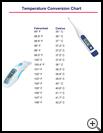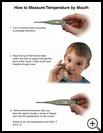
Temperature, How to Measure
Getting an accurate measurement of your child's temperature takes practice. If you have questions about these instructions, ask your healthcare provider to show you how it's done. Then ask your provider to watch you do it.
Where is the best place to put the thermometer?
A rectal (in the bottom) temperature or a temporal artery temperature are the most accurate. Temperatures measured by mouth, by electronic pacifier, or by ear are also accurate if done properly. Temperatures measured in the armpit are the least accurate, but they are better than no measurement. The best place to use the thermometer depends on the age of your child.
- For a baby less than 3 months old (90 days old):
A temporal artery or armpit temperature are best because they are safe and easy to do. If the armpit temperature is over 99°F (or 37.2°C), double check it with a rectal temperature. It is good to double check with a rectal temperature because if your baby has a true fever, you should see a healthcare provider immediately.
- For a child between 3 months and 4 or 5 years old:
A rectal, temporal artery, or electronic pacifier thermometer are best. Using an ear thermometer is fine after 6 months old if the user understands the technique. An armpit temperature is fine for a quick check if done correctly.
- For a child older than 4 or 5 years old:
Take the temperature by mouth (orally), or use a temporal artery or ear thermometer.
How to take rectal temperatures
- If you are using a digital thermometer, turn it on.
- Have your child lie stomach down on your lap.
- Before you insert the thermometer, put some water-based lubricating jelly on the end of the thermometer and on the opening of the bottom (anus).
- Insert the thermometer gently into the bottom about 1 inch. If your child is younger than 6 months old, gently insert the thermometer only 1/4 to 1/2 inch. If you put the thermometer in just until the silver tip disappears, that is about 1/2 inch. Never try to force it past any resistance. Forcing could damage the bowel.
- Hold your child still while the thermometer is in.
- Take the thermometer out when you hear the correct signal (usually a series of beeps).
- Read the temperature on the thermometer. If the rectal temperature is over 100.4°F (38°C), your child has a fever.
How to take armpit (axillary) temperatures
- Place the tip of the thermometer in a dry armpit.
- Close the armpit by holding the elbow against the chest for 4 or 5 minutes. Do not remove it before 4 minutes have passed.
- Remove the thermometer after you hear the signal (usually a series of beeps) and read the temperature on the screen.
- Your child has a fever if the armpit temperature is over 99°F (37.2°C). If you're not sure if it is correct, check it by taking a rectal temperature.
How to take oral (mouth) temperatures
- Be sure your child has not had a cold or hot drink in the last 30 minutes.
- If you are using a digital thermometer, turn it on.
- Place the tip of the thermometer under one side of the tongue and toward the back. An accurate temperature depends on putting it in the right place. Ask your healthcare provider to show you where it should go.
- Have your child hold the thermometer in place with his lips and fingers (not his teeth). He should breathe through his nose, keeping his mouth closed. If your child can't keep his mouth closed because his nose is blocked, suction out the nose.
- Leave the digital thermometer in the mouth until you hear the correct signal (usually a series of beeps).
- Read the temperature. Fever is an oral temperature over 99.5°F (37.5°C).
How to take electronic pacifier temperatures
- Have your child suck on the pacifier until the temperature stops changing and you hear a beep. This usually takes 3 to 4 minutes.
- Read the temperature. Your child has a fever if the pacifier temperature is over 100°F (37.8°C).
How to take ear temperatures
- If your child has been outdoors on a cold day, he needs to be inside for 15 minutes before taking the temperature. (Earwax, ear infections, and ear tubes, however, do not interfere with accurate readings.)
- Pull the ear backward to straighten the ear canal.
- Place the end of the thermometer into your child's ear canal and aim the probe toward the eye on the opposite side of the head. Then press the button.
- In about 2 seconds you can read the temperature.
- Your child has a fever if the ear temperature is over 100.4°F (38°C).
How to take temporal artery temperatures
- The thermometer reads the infrared heat waves released by the temporal artery which runs across the forehead just below the skin.
- Place the sensor head at the center of the forehead midway between the eyebrow and the hairline.
- To scan for your child’s temperature, depress the scan button and keep it depressed.
- Slowly slide the TA thermometer straight across the forehead toward the top of the ear keeping in contact with the skin.
- Stop when you reach the hairline and release the scan button.
- Remove the thermometer from the skin and read your child’s temperature on the display screen.
Types of Thermometers
- Glass (with mercury) thermometers
The American Academy of Pediatrics urges parents not to use glass mercury thermometers due to safety issues with mercury and broken glass. They measure temperatures slowly and are often hard to read. If you still have one of these thermometers, ask your healthcare provider how to dispose of it.
- Digital electronic thermometers
Digital electronic thermometers measure temperatures with a heat sensor and require a button battery. They measure temperatures quickly, usually in less than 30 seconds. The temperature is displayed in numbers on a small screen. The same thermometer can be used to take rectal, armpit, and oral temperatures.
Digital thermometers come in many sizes and shapes. You can get them at most supermarkets and pharmacies, and they are available in a range of prices.
- Ear thermometers
Many hospitals and medical offices now take your child's temperature using an infrared thermometer that reads the temperature of the eardrum. In general, the eardrum temperature provides a measurement that is as accurate as the rectal temperature.
The biggest advantage of this thermometer is that it measures temperatures in less than 2 seconds. It also does not require cooperation by the child and does not cause any discomfort. Ear thermometers for use at home have been developed and they cost $30 to $40. The American Academy of Pediatrics (AAP) advises against using electronic ear thermometers for infants younger than 3 months because their ear canals are usually too small.
- Temporal artery thermometers
These infrared thermometers read the temperature of the blood within the temporal artery. A temporal artery crosses the forehead on each side of the head. The readings are more accurate than ear temperatures. Their main advantage is that the temperature can be taken in seconds and without awakening the child. The disadvantage is that they cost more than any other thermometer, about $60. Newer research suggests they are accurate in younger infants.
- Digital electronic pacifier thermometers
The new electronic pacifier thermometers have a heat sensor and are powered by a button battery. These pacifiers let you measure oral temperature in younger children. To get an accurate reading, the child needs to keep the pacifier in the mouth for 3 minutes without moving. This is very difficult for most babies and toddlers.
- Temperature strips
Liquid crystal strips put on the forehead have been studied and have been found to be inaccurate. They do not detect an elevated temperature in most children with fever.
Touching the forehead is somewhat reliable for detecting fevers over 102°F (38.9°C) but tends to miss mild fevers.
Conversion of Degrees Fahrenheit (F) to Degrees Celsius (C)
Temperatures can be measured in degrees Fahrenheit (F) or degrees Celsius (C). The table below shows the temperatures in degrees Celsius that are equivalent to temperatures measured in degrees Fahrenheit:
95 degrees F = 35 degrees C
96.8 degrees F = 36 degrees C
98.6 degrees F = 37 degrees C
99 degrees F = 37.2 degrees C
99.5 degrees F = 37.5 degrees C
99 degrees F = 37.2 degrees C
100 degrees F = 37.8 degrees C
100.4 degrees F = 38 degrees C
101 degrees F = 38.3 degrees C
102 degrees F = 38.9 degrees C
103 degrees F = 39.5 degrees C
104 degrees F = 40 degrees C
105 degrees F = 40.6 degrees C
106 degrees F = 41.1 degrees C
107 degrees F = 41.7 degrees C
108 degrees F = 42.2 degrees C
Last modified: 2016-07-22
Last reviewed: 2017-06-05



